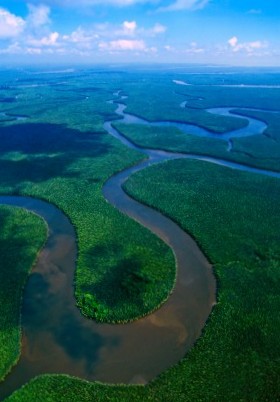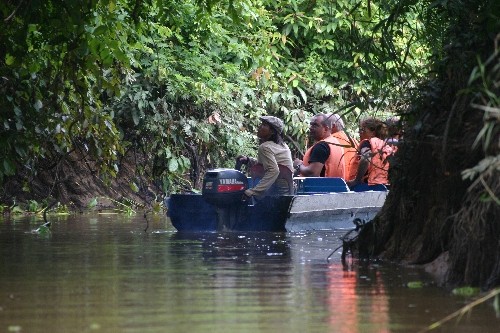The Lower Kinabatangan River and Sukau areas are known for its rich ecosystem, mangrove swamps and flood plains, and is home to its most famous inhabitants, the proboscis monkeys.

Sungai Kinabatangan is the longest river in Sabah which was declared as Sabah’s gift to the Earth in 1999. It measures about 560 kilometers from the southwest to the Sulu Sea. The upper part of the river itself has really been destroyed by clearing plantations and logging. It is pretty ironic that the riverine forest is surrounded by palm trees and palm oil plantations. The palm trees are now home to wildlife particular to that area. This only proves that life indeed finds a way. And this helps improve the environmental condition and status of Kinabatangan. This also proves that you could enjoy forward development with respect and care for life.
Every nature enthusiast’s trip to Sabah is highlighted by the wildlife of Kinabatangan. Mammals are very common in the area. You could see birds in activity from October to Math (rainy season). It was a little inconvenient to do this but you will be able to get the pictures and videos that you want. Just recently, floods that occurred annually and became worse as March approached. Because of this, the villages had to be moved. The operations of camps and lodges were halted until the waters ceased. But during the dry season, the lakes dry up completely.
From the Sandakan-Lahad Datu to the estuary surrounded by a mangrove a strip of rainforest lined the path. Here, proboscis monkeys were spotted in the mangrove forests every late afternoon. Orangutans were spotted often, settling in the surrounding trees. Macaques (pig-tailed and long-tailed) were found at any place possible.
Marbled cats could be seen in the forest if you’re lucky. Flat-headed cats are seen at night on a regular basis in Menungal (Kinabatangan’s tributary). Other animals that can be seen in the area are elephants, squirrels, and deer.
Bird watching is a very rewarding thing in Kinabatangan. All eight species of hornbill endemic to Borneo are spotted regularly here. Beautiful pittas are very commonly seen. You could also see the snake bird or the Oriental darter and the Storm’s stork as well.
Animal-spotting in Kinabatangan really depends on the knowledge of your guide and sheer luck.

What is a typical Day trip on the Kinabatangan River?
Take one of the 3 times daily boat trips up or down the river to watch the various treasured local wildlife species. These include pygmy elephants, probocis monkeys (characterized by its pendulous nose, thick white tail, fat belly, and webbed feet), wild orangutans, red leaf monkeys, silver leaf monkeys, hornbills, civet cats, etc.
A great number of bird species are quite prolific in the area. These include kingfishers, bee-eaters, egrets, hornbills, oriental darters and a lot more (see below watchlist):
Short bird watching list
- Anhingas
- Asian Barbets
- Bee-eaters
- Bristlehead
- Broadbills
- Bulbuls
- Caracaras and Falcons
- Cisticolas
- Crested Shrikejay
- Crows, Magpies and Jays
- Cuckoos
- Cuckooshrikes
- Doves and Pigeons
- Drongos
- Ducks
- Fairy Flycatchers
- Fairy-bluebirds
- Fantails
- Flowerpeckers
- Frogmouths
- Ground Babblers and Fulvetta
- Gulls, Skimmers and Terns
- Hawks, Kites and Eagles
- Herons, Bitterns and Egrets
- Hispanhiolan Tanagers
- Hornbills
- Ioras
- Kingfisher
- Laughingthrushes
- Leafbirds
- Monarch Flycatchers
- Nightjars
- Nuthatches
- Flycatchers
- Sparrows
- Orioles
- Ospreys
- Owls
- Parrots
- Pheasants and Grouses
- Pittas
- Rail-babbler
- Rails, Gallinules and Coots
- Rollers
- Sandpipers
- Scimitar-Babblers and Tree-Babblers
- Starlings
- Storks
- Sunbirds and Spiderhunters
- Swallows
- Swifts
- Thornbills
- Treeswifts
- Trogons
- Vangas
- Vireos, Erpornis and Shrike-Babblers
- Waxbills
- Woodpeckers
- Woodswallows
Detailed birdwatching list
- Abbott's Babbler
- Ashy Minivet
- Ashy Tailorbird
- Asian Emerald Dove
- Asian Fairy-bluebird
- Asian Glossy Starling
- Asian Palm-Swift
- Banded Broadbill
- Banded Woodpecker
- Barn Swallow
- Barred Eagle-Owl
- Bar-winged Flycatcher-shrike
- Bat Hawk
- Black Bittern
- Black Eagle
- Black Hornbill
- Black-and-red Broadbill
- Black-and-white Bulbul
- Black-and-yellow Broadbill
- Black-capped Babbler
- Black-capped Kingfisher
- Black-crowned Pitta
- Black-faced Kingfisher
- Black-headed Bulbul
- Black-hooded Oriole
- Black-naped Monarch
- Black-naped Oriole
- Black-nest Swiftlet
- Black-throated Babbler
- Black-winged Flycatcher-shrike
- Blue-and-white Flycatcher
- Blue-banded Kingfisher
- Blue-crowned Hanging-Parrot
- Blue-eared Barbet
- Blue-eared Kingfisher
- Blue-headed Pitta
- Blue-tailed Bee-eater
- Blue-throated Bee-eater
- Blyth's Paradise-Flycatcher
- Bold-striped Tit-Babbler
- Bornean Banded-Pitta
- Bornean Blue Flycatcher
- Bornean Bristlehead
- Bornean Crested Fireback
- Bornean Ground-Cuckoo
- Bornean Partridge
- Bornean Wren-Babbler
- Brahminy Kite
- Bronzed Drongo
- Brown Barbet
- Brown Boobook
- Brown Fulvetta
- Brown Wood-Owl
- Meiglyptes tristis (Buff-rumped Woodpecker) Endangered
- Buffy Fish-Owl
- Bushy-crested Hornbill
- Cattle Egret
- Cave Swiftlet
- Changeable Hawk-Eagle
- Charlotte's Bulbul
- Chestnut Munia
- Chestnut-bellied Malkoha
- Chestnut-breasted Malkoha
- Chestnut-rumped Babbler
- Chestnut-winged Babbler
- Chinese Egret
- Cinnamon Bittern
- Cinnamon-headed Pigeon
- Cinnamon-rumped Trogon
- Collared Kingfisher
- Common Flameback
- Common Hill Myna
- Common Iora
- Common Kingfisher
- Common Sandpiper
- Cream-vented Bulbul
- Crested Goshawk
- Crested Partridge
- Crested Serpent-Eagle
- Crested Shrikejay
- Crimson Sunbird
- Crimson-breasted Flowerpecker
- Crimson-winged Woodpecker
- Crow-billed Drongo
- Dark-necked Tailorbird
- Dark-throated Oriole
- Diard's Trogon
- Dollarbird
- Dusky Munia
- Eurasian Moorhen
- Eurasian Tree Sparrow
- Ferruginous Babbler
- Fiery Minivet
- Fluffy-backed Tit-Babbler
- Giant Pitta
- Golden-bellied Gerygone
- Golden-naped Barbet
- Gould's Frogmouth
- Gray Imperial-Pigeon
- Gray-and-buff Woodpecker
- Gray-breasted Babbler
- Gray-capped Woodpecker
- Gray-cheeked Bulbul
- Gray-faced Buzzard
- Gray-headed Babbler
- Gray-headed Canary-Flycatcher
- Gray-headed Fish-Eagle
- Great Argus
- Great Crested Tern
- Great Egret
- Great Slaty Woodpecker
- Great-billed Heron
- Greater Coucal
- Greater Green Leafbird
- Greater Racket-tailed Drongo
- Green Broadbill
- Green Imperial-Pigeon
- Green Iora
- Helmeted Hornbill
- Hodgson's Hawk-Cuckoo
- Hooded Pitta
- Horsfield's Babbler
- House Swift
- Indian Cuckoo
- Intermediate Egret
- Jambu Fruit-Dove
- Javan Pond-Heron
- Jerdon's Baza
- Large Frogmouth
- Large Green-Pigeon
- Large-billed Crow
- Lesser Adjutant
- Lesser Coucal
- Lesser Fish-Eagle
- Lesser Green Leafbird
- Lesser Whistling-Duck
- Little Egret
- Little Green-Pigeon
- Little Spiderhunter
- Long-billed Blue Flycatcher
- Long-billed Spiderhunter
- Long-tailed Parakeet
- Malaysian Blue Flycatcher
- Malaysian Nightjar
- Malaysian Pied-Fantail
- Malaysian Rail-babbler
- Maroon Woodpecker
- Maroon-breasted Philentoma
- Mossy-nest Swiftlet
- Moustached Hawk-Cuckoo
- Olive-backed Woodpecker
- Olive-winged Bulbul
- Orange-backed Woodpecker
- Orange-bellied Flowerpecker
- Oriental Darter
- Oriental Honey-buzzard
- Oriental Magpie-Robin
- Oriental Pied-Hornbill
- Osprey
- Pacific Swallow
- Pink-necked Pigeon
- Pin-tailed Parrotfinch
- Plain Sunbird
- Plain-throated Sunbird
- Plaintive Cuckoo
- Puff-backed Bulbul
- Purple Heron
- Purple-naped Spiderhunter
- Raffles's Malkoha
- Red-bearded Bee-eater
- Red-billed Malkoha
- Red-crowned Barbet
- Reddish Scops-Owl
- Red-eyed Bulbul
- Red-naped Trogon
- Red-throated Barbet
- Red-throated Sunbird
- Rhinoceros Hornbill
- Ruby-cheeked Sunbird
- Ruddy Kingfisher
- Rufous Piculet
- Rufous Woodpecker
- Rufous-backed Dwarf-Kingfisher
- Rufous-chested Flycatcher
- Rufous-collared Kingfisher
- Rufous-crowned Babbler
- Rufous-fronted Babbler
- Rufous-tailed Shama
- Rufous-tailed Tailorbird
- Rufous-winged Philentoma
- Savanna Nightjar
- Scaly-crowned Babbler
- Scarlet-backed Flowerpecker
- Scarlet-rumped Trogon
- Short-tailed Babbler
- Slender-billed Crow
- Snowy-browed Flycatcher
- Sooty-capped Babbler
- Spectacled Bulbul
- Spotted Dove
- Spotted Fantail
- Square-tailed Drongo-Cuckoo
- Stork-billed Kingfisher
- Ciconia stormi (Storm's Stork) Endangered
- Straw-headed Bulbul
- Streaked Bulbul
- Striated Heron
- Striped Wren-Babbler
- Sunda Woodpecker
- Tawny-breasted Parrotfinch
- Temminck's Sunbird
- Thick-billed Pigeon
- Thick-billed Spiderhunter
- Van Hasselt's Sunbird
- Velvet-fronted Nuthatch
- Wallace's Hawk-Eagle
- Wandering Whistling-Duck
- Waterfall Swift
- Whiskered Treeswift
- White-bellied Erpornis
- White-bellied Sea-Eagle
- White-bellied Woodpecker
- White-breasted Waterhen
- White-breasted Woodswallow
- White-chested Babbler
- White-crowned Forktail
- White-crowned Hornbill
- White-crowned Shama
- White-fronted Falconet
- White-nest Swiftlet
- White-rumped Shama
- White-tailed Flycatcher
- Wreathed Hornbill
- Wrinkled Hornbill
- Yellow-bellied Bulbul
- Yellow-bellied Prinia
- Yellow-breasted Flowerpecker
- Yellow-crowned Barbet
- Yellow-rumped Flowerpecker
- Yellow-vented Bulbul
- Yellow-vented Flowerpecker
- Zebra Dove
Please contact us for booking your Kinabatangan river wildlife and birdwatching cruise.
